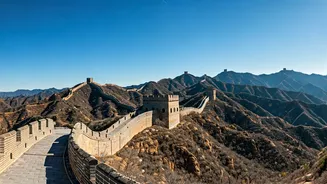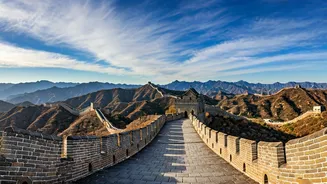Ancient Egyptian Pyramids
The first wonder to consider is the Pyramids of Giza, a monumental testament to ancient Egyptian ingenuity. These towering structures, built over 4,500
years ago, served as tombs for pharaohs and stand as enduring symbols of their power and beliefs. Explore the Great Pyramid of Giza, the largest of the three, along with the Sphinx, a guardian statue with the body of a lion and the head of a human. Consider that the precision of the construction, using massive stone blocks, continues to baffle engineers and historians to this day. A visit to the Giza Plateau offers a glimpse into a world of pharaohs, gods, and elaborate rituals, providing an unforgettable experience. The Pyramids of Giza, showcasing ancient Egyptian architecture, demonstrate a complex society's impressive organizational and engineering capabilities. Visitors find that the vastness of the site creates a sense of awe and transports them back to a time of pharaohs and mystical beliefs.
The Great Wall of China
Next on the list is the Great Wall of China, a massive defensive structure stretching over thousands of kilometers, snaking across mountains and valleys. Construction began in the 7th century BC and continued for centuries, with different dynasties adding and expanding its various sections. The wall served to protect the Chinese Empire from invasions by nomadic tribes. Walking along the wall offers panoramic views of the Chinese landscape, revealing its strategic importance and the scale of the human effort involved in its construction. Key features include watchtowers, fortresses, and passes, which provide a fascinating insight into ancient military strategies. The Great Wall's construction, involving millions of workers, stands as a testament to the organizational power and resilience of the Chinese civilization. A visit provides not only historical context, but also an unforgettable experience of the vastness and beauty of China.
Machu Picchu, Peru
Machu Picchu, the 'Lost City of the Incas,' is a mountaintop citadel in the Andes Mountains of Peru. Built in the 15th century, it was abandoned during the Spanish conquest and remained hidden for centuries before its rediscovery in 1911. The site's location provides stunning views, and the intricate stone architecture showcases the sophistication of the Inca civilization. The precision of the stonework, with stones fitting together without mortar, is a marvel of engineering. Machu Picchu offers insights into the Incas' advanced agricultural practices, religious beliefs, and social structure. Explore the temples, palaces, and residential areas, imagining life in this ancient city. The journey to Machu Picchu, whether by train or hiking the Inca Trail, is an adventure in itself, adding to the mystique of this UNESCO World Heritage site, and providing an unforgettable experience for those who visit.
The Colosseum, Italy
In the heart of Rome stands the Colosseum, an iconic amphitheater that once hosted gladiatorial contests, public executions, and mock sea battles. Built in the first century AD, it could accommodate around 50,000 spectators. The Colosseum's architectural design is a marvel of its time, incorporating innovative features such as an elaborate system of entrances, exits, and a retractable awning. This provides an insight into the entertainment and political life of ancient Rome. Visitors can explore the arena floor, the underground passages, and the seating areas, imagining the events that unfolded within its walls. The Colosseum stands as a symbol of the Roman Empire's power and ingenuity, and is an essential destination for anyone interested in history and architecture, offering a glimpse into the heart of ancient Roman society.
Taj Mahal, India
The Taj Mahal, a mausoleum in Agra, India, is a monument to love, commissioned by Mughal emperor Shah Jahan in memory of his wife Mumtaz Mahal. Built in the 17th century, the Taj Mahal is renowned for its intricate marble work, elaborate carvings, and symmetrical design, reflecting the Mughal Empire's artistic and architectural achievements. The monument's design integrates Persian, Islamic, and Indian architectural styles, resulting in a unique and breathtaking structure. The Taj Mahal is a powerful symbol of love and devotion, drawing millions of visitors who come to admire its beauty and learn about its history. Visitors can explore the gardens surrounding the Taj Mahal, the main mausoleum, and the intricate details of its marble walls. It remains one of the world's most recognizable landmarks, providing a timeless experience.
Chichen Itza, Mexico
Chichen Itza, a Mayan city in the Yucatan Peninsula, Mexico, is famous for its iconic pyramid, El Castillo. This ancient site flourished between the 9th and 12th centuries and reveals the sophistication of the Mayan civilization. The pyramid's design incorporates astronomical alignments, demonstrating the Mayans' knowledge of mathematics and astronomy. Chichen Itza features other impressive structures, including the Temple of the Warriors and the Observatory. Visiting Chichen Itza is an opportunity to explore the complex Mayan society. You can also learn about their religious beliefs, and their architectural and artistic achievements. Experiencing the site provides a glimpse into a fascinating civilization.
Christ the Redeemer
Perched atop Corcovado Mountain in Rio de Janeiro, Brazil, stands Christ the Redeemer, an Art Deco statue that has become an iconic symbol of the city. Completed in 1931, the statue is a representation of Jesus Christ, extending his arms in a gesture of welcome and peace. The statue provides stunning panoramic views of Rio de Janeiro and its surroundings, including Guanabara Bay and Sugarloaf Mountain. Visitors can take a train or hike to the summit, enjoying the scenic journey. The Christ the Redeemer statue is a testament to faith, a symbol of Brazilian culture, and a must-see for anyone visiting Rio de Janeiro. Its location gives visitors an unparalleled experience of the city.
Petra, Jordan
Petra, an ancient city in Jordan, is carved into sandstone cliffs and was established as a major trading hub by the Nabataean civilization. The city flourished from the 4th century BC to the 1st century AD, with its architecture, including the Treasury and the Monastery, showcasing a unique blend of Hellenistic and Nabataean influences. Petra is famous for its intricate rock-cut facades, its water management systems, and its strategic location along ancient trade routes. Visitors can explore the narrow Siq canyon, which leads to the Treasury, and then wander through the city. Experiencing Petra offers a glimpse into a sophisticated ancient society. The history and architecture found there offers an unforgettable adventure for travelers.
Iguazu Falls, Argentina
Iguazu Falls, located on the border between Argentina and Brazil, is a stunning natural wonder comprising hundreds of waterfalls and cascades. The falls are formed by the Iguazu River and are surrounded by lush rainforest, creating a spectacular natural setting. Visitors can explore the falls from various viewpoints, including walkways, boat tours, and hiking trails, offering a variety of perspectives. The power and scale of the Iguazu Falls is truly mesmerizing, and it's a testament to the power of nature. Observing the natural beauty and complexity of the falls provides a captivating experience. It is an extraordinary experience for any visitor, showcasing South America's natural beauty at its finest.











